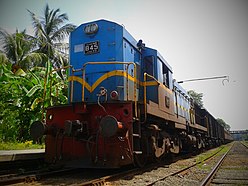Indian locomotive class WDM-2
This article needs additional citations for verification. (May 2020) |
| WDM-2 | |||||||||||||||||||||||||||||||||||||||||||||||||||
|---|---|---|---|---|---|---|---|---|---|---|---|---|---|---|---|---|---|---|---|---|---|---|---|---|---|---|---|---|---|---|---|---|---|---|---|---|---|---|---|---|---|---|---|---|---|---|---|---|---|---|---|
 19305 Indore - Guwahati Express (WR LHB Rake) hauled by offlink ALCo MGS WDM3A | |||||||||||||||||||||||||||||||||||||||||||||||||||
| |||||||||||||||||||||||||||||||||||||||||||||||||||
| |||||||||||||||||||||||||||||||||||||||||||||||||||
| |||||||||||||||||||||||||||||||||||||||||||||||||||
| |||||||||||||||||||||||||||||||||||||||||||||||||||
The Indian locomotive class WDM-2 is a class of diesel-electric locomotive that was developed in 1962 by American Locomotive Company (ALCO) for Indian Railways. The model name stands for broad gauge (W), Diesel (D), Mixed traffic (M) engine, 2nd generation (2). They entered service in 1962. A total of 2700+ WDM-2 was built at ALCO and Banaras Locomotive Works (BLW), Varanasi between 1962 and 1998, which made them the most numerous class of mainline diesel locomotive until its successor the WDM-3A.
The WDM-2 is one of the most successful locomotives of Indian Railways serving both passenger and freight trains for over 59 years. A few WDM-2 units were exported to neighboring countries like Sri Lanka and Bangladesh. Despite the introduction of more modern types of locomotives like WDG-4 and electrification, a significant number are still in use, both in mainline and departmental duties. As of October 2021, 10 locomotives still retain "operational status" on the mainline as WDM-2, with further examples in service as WDM-3A or WDM-2S.
Origin[]
The history of WDM-2 begins in the early 1960s with the stated aim of the Indian Railways to remove steam locomotives from Indian Rails after recommendation of Karnail Singh Fuel Committee.[1] Therefore, required building a large number of Co-Co diesel locomotives producing at least 2,600 HP (1,900 kW) with road switcher cabs to achieve this aim. Thus Indian Railways began looking at various diesel-electric designs.
Initially, the Indian railways invited tenders to build locomotives to the new specification. The following responses were received:
- ALCO submitted their model (RSD29 / DL560C) with 2600 hp, 16-cylinder, 4-stroke turbo-supercharged engine with Co-Co bogies.
- General Motors Electro-Motive Division (EMD) submitted their G16, turbocharged to become the GT16.[2] They had Co-Co bogies with 16-cylinder 2-stroke turbo-supercharged engines.[3]
Each company submitted their prototypes and Indian Railways designated these prototypes as the WDM-2 class and WDM-4 class respectively.[4] Technologically the General Motors WDM-4 was superior to ALCO WDM-2, but Indian Railways required a transfer of technology agreement that would allow these locomotives to be indigenously manufactured in India. Since General Motors did not agree to the transfer of technology agreement, the ALCO prototype was selected for production.
However, even before the arrival of WDM-2 another type of diesel locomotive was imported from ALCO in 1957. This locomotive was classified as WDM-1.[5] However WDM-1s were not selected for mass production because of having only one forward cab at one end which needed a lot of turntables.[6]
Production History[]
The first few prototype WDM-2 were imported with locomotive number 18040 being the first WDM-2 of India.[7][8] The need for a large number of locomotives quickly was deemed paramount. After Banaras Locomotive Works (DLW) completed construction of its factory in Varanasi, production of the locomotives began in India. The first 12 locomotives were built using kits imported from ALCO (order no. D3389) in the United States.[9]
The first diesel loco assembled in DLW was locomotive number 18233 and the first fully-built WDM-2 from DLW was 18299.[10][11][12] After that DLW started manufacturing the WDM-2 locomotives from their own components. Since then over 2,800 locomotives have been manufactured with 16887 being the last locomotive in the series.[13]
Although ALCO went bankrupt, DLW Varanasi successfully adapted the technology and produced many upgraded versions which were exported to many Broad Gauge countries.[14] Later a number of modifications were made and a few sub-classes were created. This includes WDM-2A, WDM-2B and WDM-3A (formerly WDM-2C). A few WDM-2 locomotives had been rebuilt by Diesel Loco Modernization Works (DLMW) in Patiala, Punjab.[15] These are fitted with DBRs produced by Daulat Ram Engineering.[16]
Service History[]
The whole batch of WDM2 imports went all to the Diesel locomotive shed at Katni (KTE).[17] Locomotive number 18040 was first loco in the series, but 18042 was the first WDM-2 unit to be commissioned. By 1967 the first express trains were being hauled by the WDM-2 instead of steam locomotives. Trains like the Himgiri express and Tamil Nadu express were entirely hauled by WDM-2 units.[18][19] One of the most important express trains hauled by the WDM-2 class was the Mumbai Rajdhani express.[20][21] By the 1980s the WDM-2 class was hauling most of the passenger and freight trains in India.
The WDM-2 locomotives have a maximum speed of 120 km/h (75 mph), restricted to 100 km/h (62 mph) when run long hood forward.[22]
Maintenance[]
The WDM-2 has a maintenance schedule of 3000 km or 10-days, which was recommended by ALCO.[23] These have been extended by 20 days to 30 days by using better and more efficient lubrication oils and other component fluids and improving some bearings for the suspension. The original WDM-2 bearings were very failure prone and often required minor repairing.[24] However the WDM-2 was very easy to operate and maintain because of its simple construction and mechanics which resulted in it being very reliable. This maintenance is usually done at the nearest Diesel loco shed.
Variants[]
WDM-3A[]
The WDM-3A class is actually upgraded WDM-2 designed to produce more power (3100 hp instead of 2600 hp) and increased reliability (roller bearings instead of conventional ALCO bearings). Except 150 units, rest are rebuilt WDM-2. Rebuilt WDM3As can be identified by an “R” at the end of their road number.
WDG-2/3A[]

It is the dedicated freighter version of the WDM-2 and shares the same engine and horsepower rating with WDM-3A.The first units of this class was delivered on July 18, 1995 under the name of WDG-2. The class was manufactured till end of 2015. All the older locomotives built by DLW had regular WDM-2 type, square short hood profile and control stand position. The Bogies of WDM-2 have been replaced by High adhesion Fabricated bogies for better traction and Stability.
They are hugely successful with about 1163 units of this class have been produced. They can be found all over India doing all kinds of duties like hauling freight and passenger service to shunting and departmental works.
WDM-7[]
They are lower powered (2000 HP instead of 2600 HP) version of the WDM-2. These locomotives were built from 1987 to 1989. A few were at Ernakulam earlier, but later all were transferred to Tondiarpet seen shunting at Chennai Central or for light passenger haulage. Some are at the thermal power station, Chennai.
They were formerly housed at Erode and Golden Rock also. They are reliable and rugged locomotives even though low powered. They can be easily recognized by the lack of grilles on the short hood. Two locomotives are running on a mixture of bio-diesel and diesel. All 15 are still in service.
WDP-1[]
It is a lower powered passenger (2300 HP) version of the WDM-2. The Bogies of WDM-2 have been replaced by Bo-Bo fabricated bogies with a max. Speed of 140 km/h. They were not hugely successful. About 69 units have been produced with 60 locomotives still being in service. They are easily identified by baldie grille-less short hood.
Sub-classes[]
WDM-2A[]
The WDM-2A is a variant of the original WDM-2 series that have been retro-fitted with air brakes, in addition to the original vacuum brakes.[25] So these locomotives can haul both vacuum and air braked wagons. Air brakes were introduced as the were safer and more reliable.[26] Despite this classification some WDM-2A locomotives are still marked as WDM-2 not as WDM-2A
WDM-2B[]
The WDM-2B is a variant of the original WDM-2 series built with air brakes as original equipment. They do not have vacuum brakes.[27] Only some have been classified as WDM-2B.
Jumbos[]

The WDM-2 locomotives from serial numbers around 17788 to 17890 were fitted with full-width short hood with the intention of giving them an extended visibility for the drivers.[28] These are unofficially termed 'Jumbos' by crew and Rail-fans.[29] WDM-2 #17722 and 17748 are rumored to be the prototypes of the jumbo class, but differs slightly from other Jumbos.[30][31][32] But these locomotives proved to be not that useful as the locomotive pilots raised their concerns that they had to stand up to operate them. So a few were modified to have normal short hoods of WDM-2.Some earlier Jumbo locomotives were also converted to WDM-3A.
These locomotives are easily recognizable by their short hood having big windows. After over-ageing of these locomotives, the jumbos were mainly used on Shunting or Departmental works trains. As a consequence few of them are still in service.
WDM-2S[]
This classification is given to WDM-2 which are nearing the end of their service life. These locomotives can be easily recognized by '0' at the beginning of their road number.[33] These WDM-2 locomotives are relegated to do Shunting or occasionally haul Departmental works trains.[34] Some WDM-2 remain in classification for many years before they are scrapped.
Export versions[]
Sri Lanka[]
Eight WDM-2 locomotives were purchased by the Sri Lanka Railways, the state run railroad operator in Sri Lanka in 1996. They were the longest and most powerful locomotives at that time. They were allocated the M8 class.[35][36] However, some modifications to the appearance were done by SLR.[37] These locomotives belong to road number 841 to 848 and all are still operational.
Bangladesh[]
Ten WDM-2 locomotives were purchased by Bangladesh Railway in 2001. They were the most powerful locomotives at that time. They were allocated Class 6400 or BED-26 numbered from 6401 to 6410. All are fitted with air brake and AAR coupling. Unlike their Indian counterparts, these locomotives do not have the dynamic braking system. All locomotives are still in service
Loco Road numbers[]
During the manufacture of WDM-2, DLW built these locomotives in non chronological matter.[38]
18040-079/18112-18232 series locomotives[]
These locomotive were among the first WDM-2s to roam India. Locomotive number 18040 is the first in the series to be imported and subsequent ones were later supplied by ALCO. Locomotives numbered from 18080 to 18111 are actually WDM-4 class. These WDM-2 locomotives can be easily identified by their original ALCO dynamic brake vents with three partitions.[39] They were mostly in mainline service till 2007 and were relegated to shunting/departmental duties thereafter. The last of these locomotives (WDM-2 numbered 18068 from kurla) were condemned by March 2014.[40][41] All of these locomotive has been withdrawn from service and scrapped now.
18232-18514 series locomotives[]
After 18232, DLW started manufacturing locomotives from kits supplied by ALCO. The first kit-built from DLW was 18233 name 'kundan' and subsequent ones were later assembled in DLW from kits supplied by ALCO after technology transfer took place. Some of these locomotives (like WDM-2 18236) have retained their original ALCO dynamic brake vents with three partitions.[42] The first fully-built WDM-2 from DLW was 18299.These locomotives were mostly in mainline service till 2007 and were relegated to shunting/departmental duties thereafter like ALCO built ones. The last of these locomotives (WDM-2 numbered 18473) were condemned by November 2013.[43]
After 18514, DLW started manufacturing locomotives with 17 series
17100-17999/ '17' series locomotives[]
DLW stopped 18 series midway (18499) and started producing 17 series locomotives. Locomotives numbered from 17000 to 17099 are WDM-1 class. These were fully-built WDM-2 locomotives from DLW. The loco numbers 17796-17895 are the 'Jumbo' versions of WDM-2. Almost all of the jumbos WDM-2 belongs to this series. Most of these locomotives were manufactured in the 70's. The 17 series locomotives are no more used for Mainline services, these are now fit only for shunting and inferior activities with most of them being condemned/scrapped.[44]
18514-18522 are WDM-3 locomotives built by German Manufacturers Henschel.
18523-18900/18903-18999 series locomotives[]
The locomotives numbering from 18530+ onward were manufactured from early 1980's. Almost all locomotives were rebuilt to WDM-3A standards, but most reverted to WDM-2 standards as they reach the end of their service life. A few are still in mainline service as WDM-3As. Most of them are fit only for shunting and inferior activities with half of them being condemned/scrapped. They still have about 1–2 years of railway service left in them.
18901 and 18902 are WDM-6 which are no longer in service
16000-16887/ '16' series locomotives[]
The 16 series are the youngest in the WDM-2 series. The oldest of their series locomotive number 16001 was manufactured in mid 80's. They are originally WDM2's and all were rebuilt to WDM-3A standards except for locomotives lost to accident damage.[45] All 16 series locomotives are still running in mainline duties as WDM-3A class. About 30 units remain as pure WDM-2s are still in service. Scrapping of the 16 series has now begun.
Liveries[]
- RTM : *1.Red top, Navy blue bottom and white band middle. - *2.Light Blue top, Navy blue bottom and white band middle. - 3.Typical Patiala Workshop livery dark blue top, bottom and white band middle.
- TNP: Light and dark blue bottom. Flying bird on pink background was the logo. Few biodiesel ones were green.
- ERS: A Kerala-based logo with characteristic ICF Rajdhani livery.
- ED: Prancing deer of IR, dark blue with white.
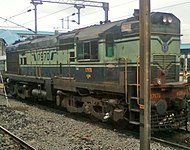
KJM (SWR): dark blue/light blue livery and logo has SWR written in white on blue background.
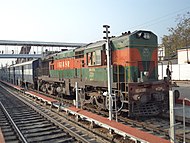
BKSC:green orange livery similar to Bangladeshi national flag.

VSKP: red yellow maroon livery

Bondamunda had a red yellow maroon livery somewhat similar to VSKP
- * = Forbidden
Preserved Examples[]
A number of WDM-2 locomotives have been preserved all over India with some units still in service.[46][47]
| Class | Manufacturer | Loco Number | Previous shed | Name | LIvery | Location | ref |
|---|---|---|---|---|---|---|---|
| WDM-2B | DLW | 17263 | Malda Town (MLDT) | MLDT blue/cream/blue with red lining | To be plinthed at Kishanganj (KNE) station of Katihar Division, NFR [20/12/2013] | [48] | |
| WDM-2 | DLW | 17445 | Kazipet (KZJ) | Earmarked for preservation: I.R. Heritage Website [November 2018] | [49] | ||
| WDM-3A/2A | DLW | 17754 | Ludhiana (LDH) | LDH grey/red/grey with white lining | Earmarked for preservation: I.R. Heritage Website [November 2018] | [50] | |
| WDM-2 | ALCO | 18040 | Katni(KTE) | Maroon with yellow lining & blue Stripes | Preserved at National Railway Museum, Delhi | [51][52] | |
| WDM-2 | ALCo | 18119 | Itarsi (ET) | Light blue with white band | Plinthed at Zonal Railway Training Institute, Bhusaval | [53][54] | |
| WDM-2A | ALCo | 18160 | Ernakulam (ERS) | Red | This loco is preserved in GOC workshop. | [55] | |
| WDM-2 | DLW | 18233 | Mughalsarai (MGS) | Kundan | Red/white/grey | Permanent Exhibit at DLW, Varanasi | [56] |
| WDM-2B | DLW | 18575 | Malda Town (MLDT) | MLDT blue/cream/blue with red lining | Earmarked for preservation: I.R. Heritage Website [November 2018] | [57] | |
| WDM-2/3A | DLW | 18599 | Krishnarajapuram (KJM) | KJM blue/turquoise/blue with blue lining | Plinthed at SWR Headquarters Office - Rail Soudha, Hubballi, glass panels on one side | [58] |
Locomotive sheds[]
| Zone | Name | Shed Code | Quantity |
|---|---|---|---|
| Eastern Railway | Jamalpur | JMP | 1 |
| North Western Railway | Abu Road | ABR | 3 |
| Southern Railway | Golden Rock | GOC | 3 |
| Tondiarpet | TNP | 2 | |
| West Central Railway | New Katni Junction | NKJ/KTE | 1 |
| Total Locomotives Active as of 18-10-2021[59][60] | 10 | ||
Former sheds[]
- Andal (UDL)
- Bardhaman (BWN)
- Bokaro Steel City (BKSC)
- Bondamunda (BNDM)
- Deen Dayal Upadhaya (DDU)
- Ernakulam (ERS)- The very last WDM-2 (18701) was removed from service in June 2019 after being in the shed for 38 years.
- Erode (ED)
- Gonda (GD)
- Gooty (GY)
- Guntakal (GTL)
- Howrah (HWH)
- Itarsi (ET)
- Izzatnagar Loco Shed (IZN)
- Jhansi (JHS)
- Kalyan (KYN)
- Kazipet (KZJ)
- Kharagpur (KGP)
- Krishnarajapuram (KJM)
- Lucknow (LKO)
- Ludhiana (LDH)
- Moula Ali (MLY)
- Pune (PUNE)
- New Guwahati (NGC)
- Raipur (R)
- Loco Shed Patratu (PTRU)
- Ratlam (RTM)
- Samastipur (SPJ)
- Tughlakabad (TKD)
- Vatva (VTA)
- Visakhapatnam (VSKP)
- Malda Town (MLDT)
Technical specifications[]
| Manufacturers | Alco, DLW |
| Engine | Alco 251-B, 16 cylinder engine, 2,600 hp (1,900 kW) (2,430 hp or 1,810 kW site rating) with Alco 710/720/?? turbo supercharged engine. 1,000 rpm max, 400 rpm idle; 228 mm × 266 mm (8.98 in × 10.47 in) bore x stroke; compression ratio 12.5:1. Direct fuel injection, centrifugal pump cooling system (2,457 L/min or 540 imp gal/min or 649 US gal/min at 1,000 rpm), fan driven by eddy current clutch (86 hp or 64 kW at 1,000 rpm) |
| Governor | GE 17MG8 / Woodwards 8574-650 / Medha MEG 601 |
| Transmission | Electric, with BHEL TG 10931 AZ generator (1,000 rpm, 770 V, 4,520 A) |
| Traction motors | GE752 (original Alco models) (405 hp or 302 kW), BHEL 4906 BZ (AZ?) (435 hp or 324 kW) and (newer) 4907 AZ (with roller bearings) |
| Axle load | 18.8 t (18.5 long tons; 20.7 short tons) |
| total weight | 112.8 t (111.0 long tons; 124.3 short tons) |
| Bogies | Alco design cast frame trimount (Co-Co) bogies |
| Starting TE | 30.4 t (29.9 long tons; 33.5 short tons), at adhesion 27% |
| Length over buffer beams | 15,862 mm (52 ft 1⁄2 in) |
| Distance between bogies | 10,516 mm (34 ft 6 in) |
Image gallery[]

Kundan, the first WDM-2 locomotive assembled at DLW
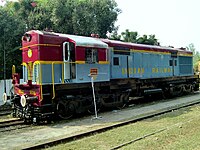
The first WDM-2 18040 preserved at national rail museum, New delhi
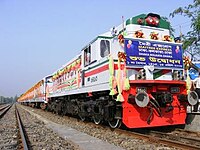
WDM-2 is known as Class 6400 in Bangladesh
See also[]
References[]
| Wikimedia Commons has media related to Indian locomotive class WDM2. |
- ^ "Report of the expert Committee on Coal Consumption on Railways, 1958". INDIAN CULTURE. Retrieved 29 April 2020.
- ^ "wdm3_001.jpg". www.irfca.org. Retrieved 29 April 2020.
- ^ "WDM-4 specs for IR" (PDF).
- ^ "[IRFCA] Indian Railways FAQ: Locomotives - General Information - I". www.irfca.org. Retrieved 18 April 2020.
- ^ "Four decades of service: The early workhorses of India's diesel age - National Rail Museum". Google Arts & Culture. Retrieved 29 April 2020.
- ^ "Diesel Locomotive Roster – The WDM (ALCO) Series". 24 Coaches. 30 October 2013. Retrieved 29 April 2020.
- ^ "[IRFCA] Indian Railways Locomotive Roster National Railway Museum, Delhi (NRM) WDM-2 18040 Show". www.irfca.org. Retrieved 29 April 2020.
- ^ Images, Historical Railway (31 December 2019), India Railways - Indian Government Railways Class WDM2 (DL560C) diesel locomotive Nr. 18041 (Alco 84199 / 1962), retrieved 29 April 2020
- ^ "[IRFCA] Indian Railways FAQ: Diesel and Electric Locomotive Specifications". www.irfca.org. Retrieved 18 April 2020.
- ^ "[IRFCA] Indian Railways Locomotive Roster Mughalsarai (MGS) WDM-2 18233 Show". www.irfca.org. Retrieved 19 April 2020.
- ^ "[IRFCA] Indian Railways FAQ: Production Units and Workshops". www.irfca.org. Retrieved 29 April 2020.
- ^ "[IRFCA] Indian Railways Locomotive Roster Bondamunda (BNDM) WDM-2 18299 Show". www.irfca.org. Retrieved 19 April 2020.
- ^ "[IRFCA] Indian Railways Locomotive Roster Gonda (GD) WDM-3A 16887 Show". www.irfca.org. Retrieved 29 April 2020.
- ^ "History of DLW, varanasi".
- ^ "dmw works" (PDF).
- ^ "Daulat Ram Engineering serving Railway Industry worldwide". www.daulatram.com. Retrieved 29 April 2020.
- ^ "Katni shed history" (PDF).
- ^ "WDM-2 with himgiri".
- ^ "TamilNadu-Dhaulpu.jpg". www.irfca.org. Retrieved 29 April 2020.
- ^ "DualWDM2Raj_BVI_1986.jpg". www.irfca.org. Retrieved 29 April 2020.
- ^ "WDM2A18425". www.irfca.org. Retrieved 29 April 2020.
- ^ Sheeju Chandran. "Interactive Diagram of the WDM-2 Locomotive". Indian Railways Fan Club. Retrieved 2 April 2010.
- ^ "WDM-2 maintenance book" (PDF).
- ^ "Maintenance Handbook on Roller Bearing fitted on WDM2" (PDF).
- ^ "[IRFCA] Indian Railways FAQ: Locomotives -- Specific classes : AC Electric". www.irfca.org. Retrieved 29 April 2020.
- ^ "[IRFCA] Brake systems used by IR". www.irfca.org. Retrieved 29 April 2020.
- ^ "Diesel Locomotive Roster – The WDM (ALCO) Series". 24 Coaches. 30 October 2013. Retrieved 29 April 2020.
- ^ "[IRFCA] Indian Railways Locomotive Roster Shakurbasti (SSB) WDM-2 17890 Show". www.irfca.org. Retrieved 18 April 2020.
- ^ "[IRFCA] WDM-2 'Jumbo' locos". www.irfca.org. Retrieved 29 April 2020.
- ^ "[IRFCA] Indian Railways Locomotive Roster Mughalsarai (MGS) WDM-2 17722 Show". www.irfca.org. Retrieved 18 April 2020.
- ^ "[IRFCA] Indian Railways Locomotive Roster Vishakapatnam (VSKP) WDM-2 17748 Show". www.irfca.org. Retrieved 18 April 2020.
- ^ "17722 'JUMBO'".
- ^ "018210_G_001.jpg". www.irfca.org. Retrieved 29 April 2020.
- ^ "WDM-2S". www.irfca.org. Retrieved 29 April 2020.
- ^ "Class M8". 18 September 2012.
- ^ "Account Suspended". www.srilankanlocos.com. Archived from the original on 20 March 2019. Retrieved 21 June 2019.
- ^ "෴අඟුරු නොකා වතුර නොබී කොළඹ දුවන යකඩ යකා෴: ෴M8 දුම්රිය එන්ජිම - අපේ අසල්වැසි රට වන ඉන්දියාවේ නිෂ්පාදනයක්෴". 6 February 2011.
- ^ "[IRFCA] Indian Railways FAQ: Diesel and Electric Locomotive Specifications". www.irfca.org. Retrieved 16 April 2020.
- ^ "100_0567". www.irfca.org. Retrieved 29 April 2020.
- ^ "[IRFCA] Indian Railways Locomotive Roster Kurla (CLA) WDM-2 18068 Show". www.irfca.org. Retrieved 16 April 2020.
- ^ Garg, Anil Kumar. "608371-0: CLA WDM2/S #18068 Original Alco built WD - Railway Enquiry". indiarailinfo.com. Retrieved 2 May 2020.
- ^ "[IRFCA] Indian Railways Locomotive Roster Erode (ED) WDM-2 18236 Show". www.irfca.org. Retrieved 16 April 2020.
- ^ "[IRFCA] Indian Railways Locomotive Roster Itarsi (ET) WDM-2 18473 Show". www.irfca.org. Retrieved 16 April 2020.
- ^ "WDM-2S". www.irfca.org. Retrieved 29 April 2020.
- ^ "[IRFCA] Indian Railways Locomotive Roster List". www.irfca.org. Retrieved 16 April 2020.
- ^ "Ministry of Railways (Railway Board)". www.indianrailways.gov.in. Retrieved 14 April 2020.
- ^ "preserve loco list".
- ^ "[IRFCA] Indian Railways Locomotive Roster Malda Town (MLDT) WDM-2 17263 Show". www.irfca.org. Retrieved 16 April 2020.
- ^ https://www.irfca.org/apps/locos/show/4560?list_type=preserved&page=2[permanent dead link]
- ^ https://www.irfca.org/apps/locos/show/3325?list_type=preserved
- ^ https://www.irfca.org/apps/locos/show/3571?list_type=preserved
- ^ "First Wdm-2 pic".
- ^ https://www.google.com/maps/uv?hl=en&pb=!1s0x3bd9a5eb86459be9%3A0x2c5c4e4e37329d93!3m1!7e115!4shttps%3A%2F%2Flh5.googleusercontent.com%2Fp%2FAF1QipPvNmCeyuzqQFdn3QxVc1Aym_iOkkgk-k1NHFMs%3Dw213-h160-k-no!5sZonal%20Railway%20Training%20Institute%2C%20Bhusawal%2018119%20-%20Google%20Search&imagekey=!1e10!2sAF1QipNQ7r1LQKdYds0ggU8VM364zs8niVE5VSejAI_4&sa=X&ved=2ahUKEwjWpMPRh-3oAhVYzzgGHZk-A5sQoiowG3oECBgQBg. Missing or empty
|title=(help) - ^ https://www.irfca.org/apps/locos/show/3618?list_type=preserved
- ^ https://www.irfca.org/apps/locos/show/3659?list_type=preserved&page=2
- ^ "[IRFCA] Indian Railways Locomotive Roster Mughalsarai (MGS) WDM-2 18233 Show". www.irfca.org. Retrieved 16 April 2020.
- ^ "[IRFCA] Indian Railways Locomotive Roster Malda Town (MLDT) WDM-2 18575 Show". www.irfca.org. Retrieved 16 April 2020.
- ^ "[IRFCA] Indian Railways Locomotive Roster Krishnarajapuram (KJM) WDM-3A 18599 Show". www.irfca.org. Retrieved 16 April 2020.
- ^ "Railway Website Mechanical Department". Retrieved 16 May 2020.
- ^ https://indianrailways.gov.in/railwayboard/uploads/directorate/mec_engg/downloads/freight/2021/Diesel%20loco%20availability%20targets%20for%20June%202021.pdf
Notes[]
Bibliography[]
- Hughes, Hugh (1996). Indian Locomotives: Part 4 – 1941–1990. Harrow, Middlesex: The Continental Railway Circle. ISBN 0-9521655-1-1.
- Diesel-electric locomotives of India
- Co-Co locomotives
- ALCO locomotives
- Railway locomotives introduced in 1962
- 5 ft 6 in gauge locomotives
